Published October 18, 2025
Explore the best APIs for menu nutrition data, offering solutions for calorie counts, allergen tracking, and compliance with FDA standards.

Want to simplify nutritional data for your restaurant? APIs are the solution. They automate tasks like calorie counts, allergen tracking, and compliance with U.S. FDA menu labeling rules. Here’s a quick overview of the top APIs for menu nutrition data:
Each API caters to different needs, from small businesses to large chains, offering features like recipe analysis, compliance tools, and integration with health apps. Below is a comparison table to help you choose the right one.
| API | Database Size | US Compliance | Pricing | Key Features |
|---|---|---|---|---|
| Edamam | 900K+ foods, 2.3M recipes | Yes | Free–$999/month | Recipe analysis, diet-specific data |
| USDA FoodData | 300K+ foods | FDA verified | Free | Government-backed, reliable data |
| Nutritionix | 1.9M+ foods | Yes | Free–$1,850+/month | NLP, geolocation, restaurant data |
| Spoonacular | 365K+ recipes | Partial | Free–$149/month | Recipe-focused, meal planning |
| Nutritics | 800K+ foods/recipes | Yes | Custom pricing | Automated food labeling |
| FatSecret | 1.9M+ foods | Yes | Free–Custom enterprise | Barcode scanning, multi-language |
| Open Food Facts | 2.5M+ products | Partial | Free | Crowd-sourced, open database |
| Bytes AI | Restaurant-specific menus | Yes | $259.99–$279.99/month | AI-powered, POS integration |
Pick an API based on your restaurant’s size, budget, and specific needs. Free options like USDA FoodData Central are great for compliance, while premium tools like Nutritionix or Bytes AI offer advanced features for larger operations.
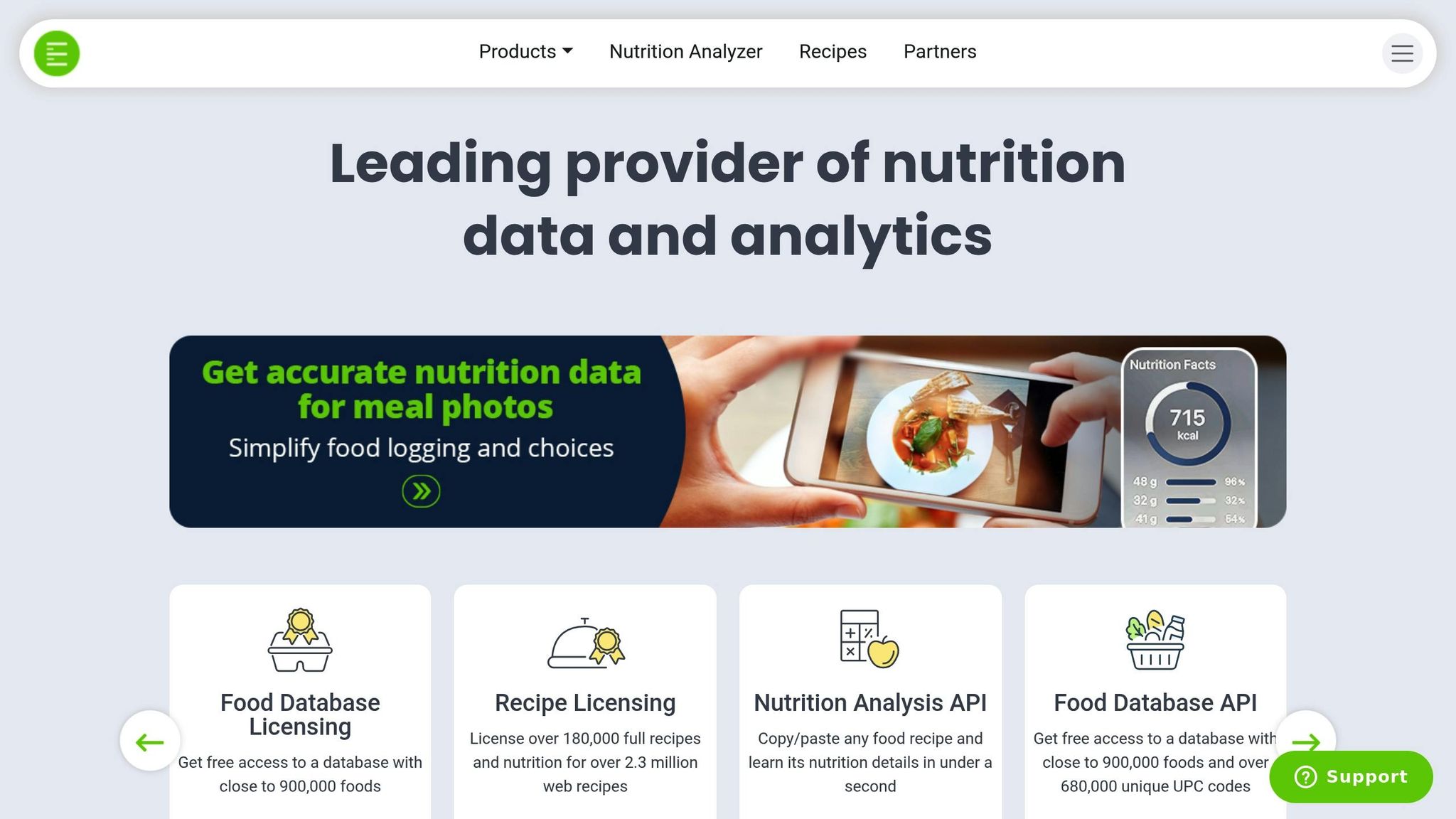
Edamam's Nutrition Analysis API is a powerful tool that uses natural language processing to turn plain-English recipes into detailed nutritional profiles in no time. Let's explore what makes it stand out, from its extensive database to its user-friendly integration and US-focused features.
Edamam boasts an impressive database that includes over 900,000 foods, 680,000+ unique UPC codes, and 2.3 million recipes. This massive collection covers everything from generic ingredients and branded products to a wide variety of recipes. It’s designed to cater to a broad spectrum of needs, including restaurant operations of all sizes. The platform also supports 40+ major diets and provides insights relevant to 200+ chronic conditions.
The API provides data on more than 150 nutrients per food item and adheres to US menu labeling standards. This includes information on macronutrients, micronutrients, vitamins, minerals, and dietary attributes like gluten-free or vegan options. All data is sourced from trusted and reputable databases.
One of Edamam's standout features is its natural language processing capability. Restaurants can input recipes in everyday language - think "grilled chicken salad with mixed greens, cherry tomatoes, and balsamic dressing" - and instantly receive a full nutritional breakdown. The RESTful API is backed by detailed documentation, making integration straightforward. To further simplify the process, Edamam provides sample code, SDKs, and responsive support via phone and email.
Designed with US businesses in mind, Edamam supports customary units and offers flexible pricing plans. The Nutrition Analysis API starts with a free tier and scales to $49 per month for higher usage, with custom pricing options for unlimited access. For businesses with broader needs, the Food & Grocery Database API ranges from free to $799 per month, while the Recipe Search API goes up to $999 per month.
Additionally, the platform ensures that all nutritional data aligns with US labeling standards. This includes proper decimal formatting (periods instead of commas) and the use of standard American nutritional terminology, ensuring menus and digital displays meet customer expectations.
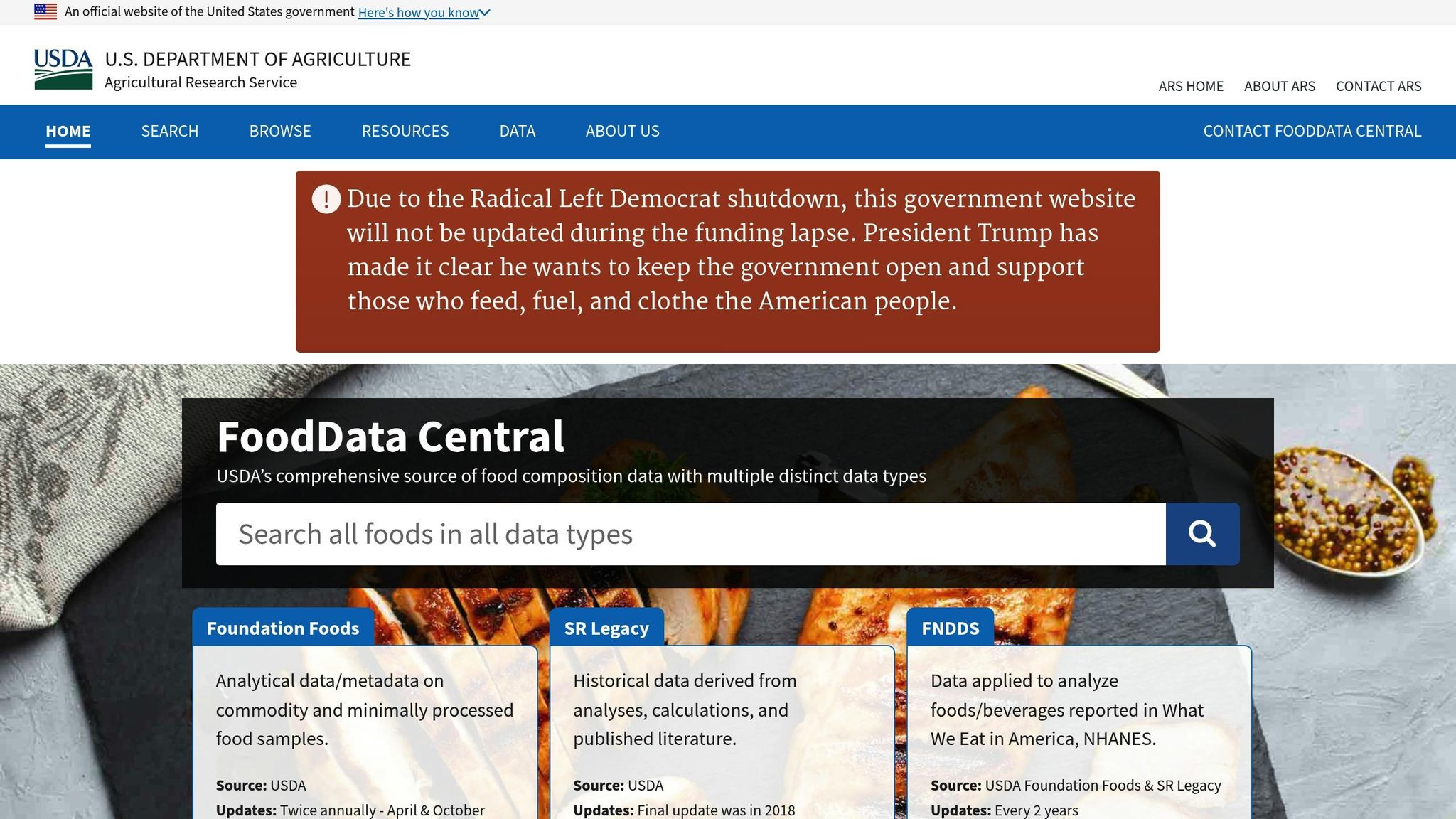
The USDA FoodData Central API stands out as a trusted source for nutritional information, backed by the reliability of the United States Department of Agriculture. As a free and publicly accessible resource, it offers restaurants a dependable way to access accurate nutrition data. Its government endorsement ensures a high standard of reliability and accuracy.
This API opens the door to a massive database of over 300,000 food items, ranging from everyday ingredients to branded products and popular restaurant menu items found across the United States. The database is organized into four main categories: Standard Reference foods, Foundation Foods, Branded Foods, and the Food and Nutrient Database for Dietary Studies (FNDDS).
What sets this API apart is its deep focus on American food products and dietary habits. It includes everything from basic staples like flour and vegetables to more complex branded items and restaurant dishes. This extensive variety ensures restaurants have access to nutritional data for both simple ingredients and intricate menu components.
Maintained by the USDA, the API provides highly accurate nutritional data that meets strict US regulatory standards for labeling and reporting. Its reliability is underscored by its widespread use among health professionals, researchers, and government agencies.
The API's nutritional information aligns with FDA and USDA guidelines, and the database is updated multiple times a year. These updates include new branded products, revised nutrient values, and corrections, ensuring restaurants always have access to the most current and precise information for menu planning and compliance.
The API uses a RESTful interface, delivering JSON data through standard HTTP requests. This is paired with detailed public documentation, making it easy for developers to integrate and customize. Flexible query options allow users to search for foods, retrieve nutrient profiles, and even analyze recipes.
Since the API is completely free, developers can dive in without worrying about subscription fees or trial limitations. This ease of access makes it a practical choice for restaurants looking to streamline compliance and cater to customer needs.
Designed with a strong focus on US standards, the API supports both US customary and metric units, ensuring compatibility with FDA labeling requirements. Its structure aligns with FDA guidelines, offering nutrient panels and allergen details formatted specifically for US food labeling.
For restaurants, this means they can effortlessly create FDA-compliant nutrition labels without needing additional tools or formatting. The inclusion of allergen information and dual-unit support is especially helpful for smaller establishments looking for cost-effective solutions to meet regulatory standards.
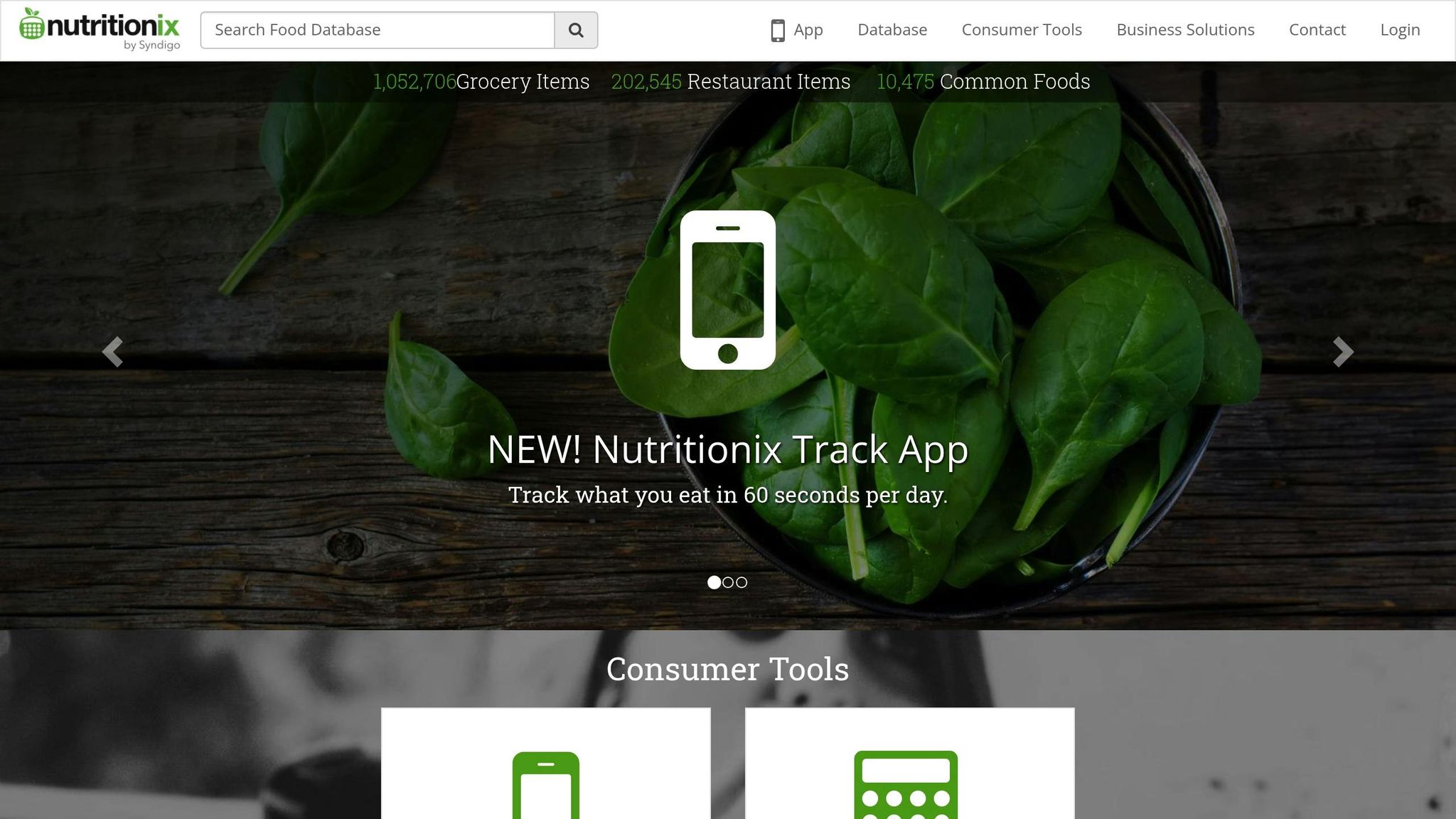
The Nutritionix API handles a staggering 700 million calls every month and is trusted by over 35,000 developers worldwide. Its extensive database and user-friendly tools have made it a go-to solution for restaurants looking to integrate nutrition data.
Nutritionix boasts a massive database of over 1.9 million unique food items, including 991,000+ grocery foods and 202,000 restaurant menu items. It also provides detailed nutritional data for more than 209,000 restaurant locations across the United States and supports over 600,000 UPC codes with an impressive 92% match rate.
To ensure accuracy, Nutritionix employs full-time registered dietitians who oversee data verification and API processes. The database, originally built on USDA data, is routinely updated to align with US nutritional labeling standards. New branded foods, restaurant dishes, and recipes are continuously added, keeping the information current and reliable.
One of the standout features of the Nutritionix API is its advanced natural language processing. This allows users to input casual text and receive instant nutritional analysis, streamlining tasks like menu entry and recipe evaluation. The API also includes endpoints for autocomplete, UPC lookups, and geolocation-based restaurant data. With support for 24 languages, along with detailed documentation and SDKs, developers can quickly integrate it into both web and mobile applications.
Designed with the US market in mind, Nutritionix supports measurements in imperial units like ounces, pounds, and cups. It also provides nutritional labels that comply with FDA regulations, helping restaurants meet menu labeling requirements. Pricing starts with a free tier for up to 2 active users, while enterprise plans begin at $1,850 per month, all priced in US dollars. Paid plans include a 99.9% uptime guarantee. The addition of geolocation data enhances its relevance for local markets, making Nutritionix a strong contender in the nutrition API space.
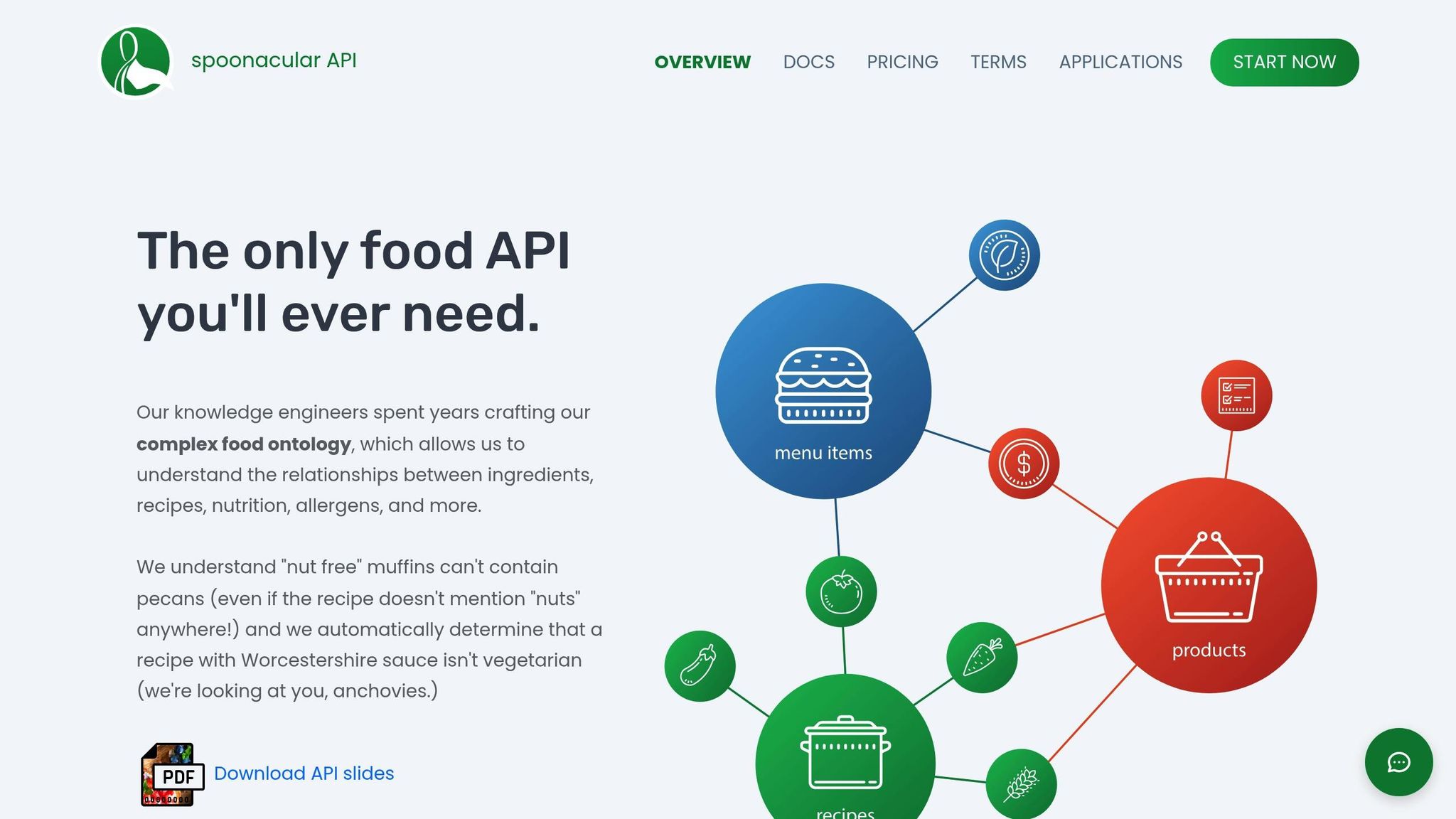
Spoonacular brings a unique twist to nutrition data solutions by combining recipe management with meal planning, making it a standout choice for integrating nutrition data into menus and health apps. With a robust database of 365,000 recipes, Spoonacular caters to those seeking a seamless connection between nutrition analysis and menu management, especially in restaurant settings.
Spoonacular's database offers over 365,000 recipes alongside a wide range of food products, making it a valuable resource for restaurants and health-focused apps. Beyond recipes, it includes grocery items and restaurant menu data, providing a well-rounded platform for nutritional analysis and menu development. This broad coverage ensures users can access detailed information for diverse culinary and dietary needs.
The API delivers comprehensive macronutrient and micronutrient details, but restaurants are responsible for ensuring FDA compliance independently. For businesses needing to meet federal menu labeling requirements, cross-checking with USDA FoodData Central or similar compliance-oriented APIs is advisable.
Spoonacular prioritizes ease of use with its RESTful API, supported by detailed documentation. It works seamlessly with popular programming languages like Python, JavaScript, and Java, making integration straightforward. With endpoints for recipe searches, nutrition analysis, and meal planning, developers can quickly incorporate its features into their applications.
Designed with US-based restaurants in mind, Spoonacular supports customary units and provides nutrition facts panels tailored to US labeling formats. While this simplifies compliance with FDA standards, businesses should verify regulatory adherence before usage. The API also includes allergen detection and customizable nutrition labels. Pricing starts with a free tier for basic needs, scaling up to $149 per month for advanced features and higher usage volumes.
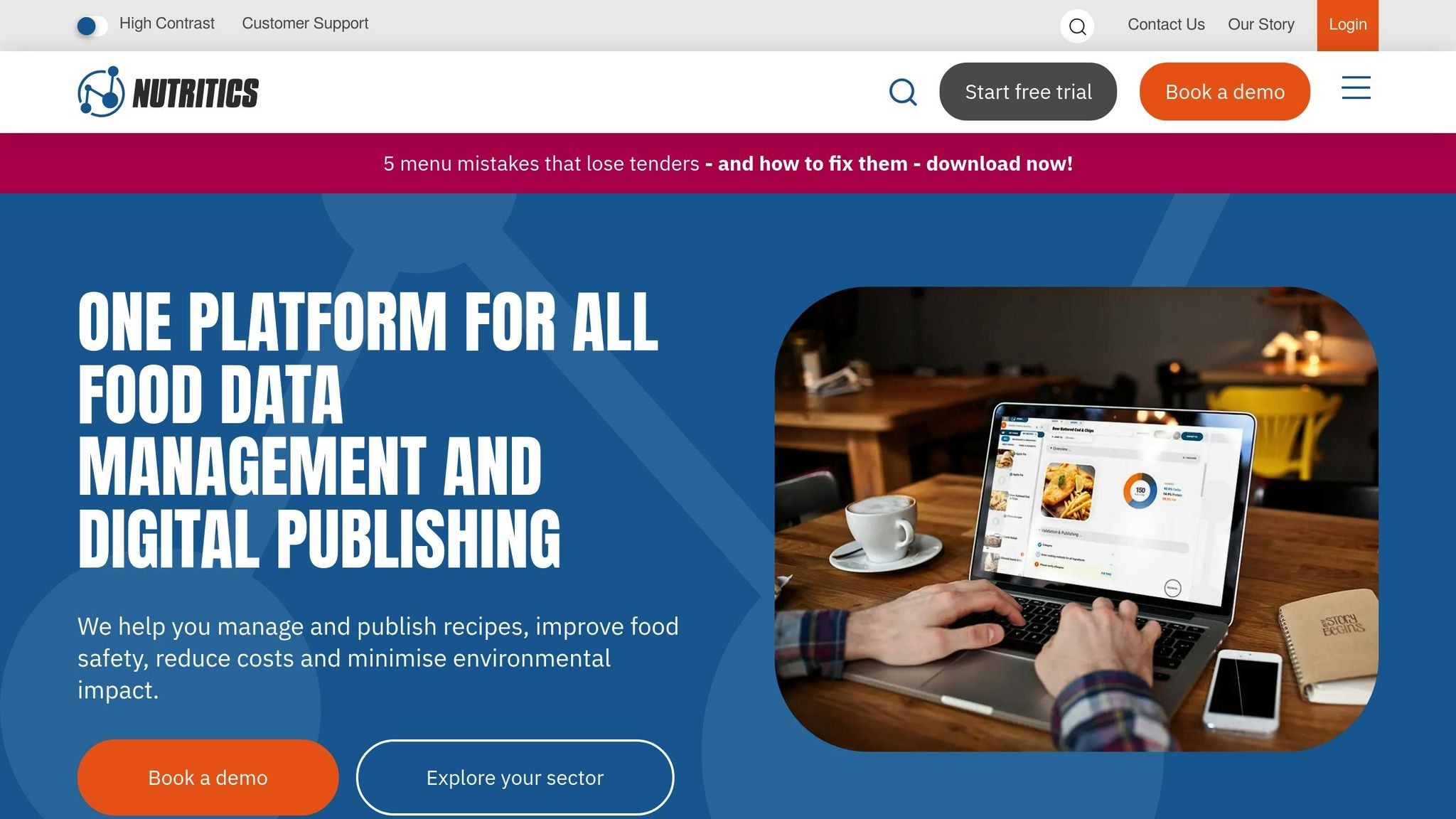
Nutritics streamlines nutrition analysis by combining automation with a vast international database. With access to over 800,000 food recipes and nutrition entries, this API simplifies the process of managing menu nutrition through its powerful calculation engine, cutting down on manual work.
The Nutritics Food Data API offers access to an impressive database of over 800,000 food recipes and nutrition data points, including entries from both national and international branded food databases. It covers a wide range of foods, recipes, and ingredients, making it a go-to resource for detailed nutritional analysis across various food categories. The SmartSearch system makes it easy for developers to quickly find product details, recipes, allergen information, and nutrition facts. This extensive data is the backbone of precise and automated nutrition management.
Nutritics’ calculation engine takes care of complex nutrition analysis, drastically reducing the need for manual input. One standout feature is its ability to generate food labels automatically - an essential tool for US restaurants aiming to comply with FDA nutrition labeling requirements. While the system supports US regulatory standards, restaurants must verify that the labels align with the latest FDA guidelines. This level of precision makes integrating the API into existing workflows a smoother process.
The API supports seamless syncing of recipes, customer data, and supplier inventories. It also allows for automation of meal plan creation and food diary analysis, making it an excellent choice for restaurants looking to offer personalized nutrition insights to health-conscious diners. Real-time nutrition calculations and reporting further reduce the workload on restaurant teams, helping them focus on delivering exceptional service.
Designed with the US market in mind, Nutritics includes food labeling features that adhere to US regulatory standards and supports US customary units. Its pricing is flexible, tailored to different editions and industries, including food service and manufacturing. For those hesitant to commit, Nutritics offers a free trial without requiring a contract or credit card, making it accessible for businesses of all sizes. Additionally, the API ensures restaurants have up-to-date nutrition data, enabling dynamic menu updates and improving customer-facing applications. This US-focused approach helps restaurants stay compliant while elevating their digital menu management capabilities.
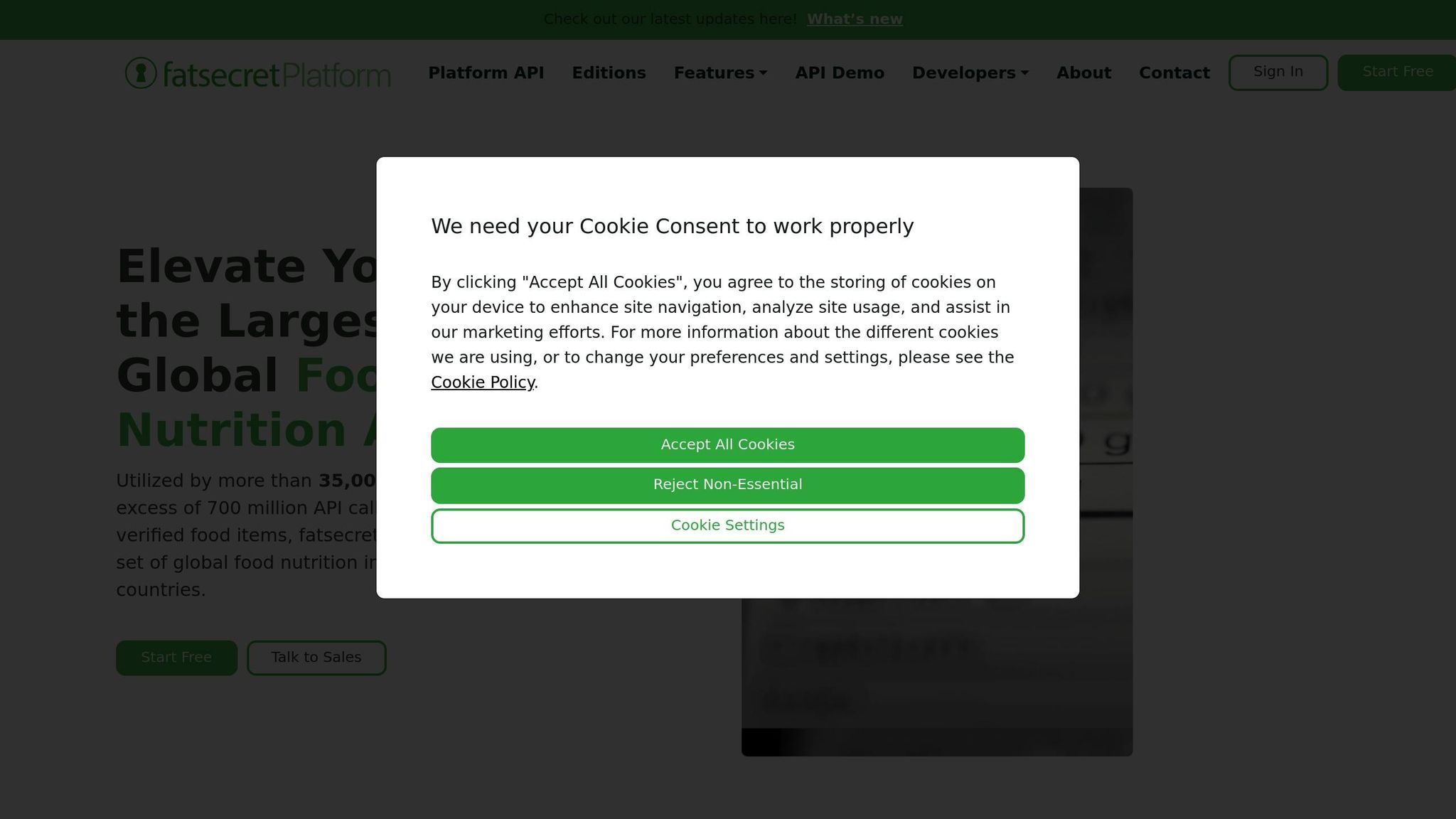
FatSecret Platform API is a powerful tool for managing menu nutrition, offering an extensive database and features designed to simplify operations. With access to over 1.9 million food items - spanning branded products, restaurant menus, and generic foods - it’s a robust resource for businesses looking to optimize their nutritional offerings.
The API’s database is packed with over 1.9 million entries, including a wide range of U.S.-branded and restaurant foods. One standout feature is its barcode scanning capability, which allows staff to quickly pull up nutritional details directly from product packaging. This not only speeds up menu analysis but also reduces the need for manual data input.
FatSecret ensures its nutritional data is reliable by sourcing it from verified manufacturer inputs and user contributions, with most entries based on official nutrition labels. The API supports standard nutrition facts panels and adheres to FDA labeling requirements. This level of accuracy is especially crucial for businesses that need to comply with menu labeling laws.
Integration is made simple with FatSecret’s RESTful endpoints, detailed documentation, sample code, and sandbox environments. Features like advanced food search tools, nutrition analysis, and barcode scanning - designed for both web and mobile platforms - make implementation straightforward and efficient. These tools are tailored to align with U.S. standards, ensuring a smooth setup process.
FatSecret’s API supports both imperial and metric units, with nutrition data formatted to meet FDA guidelines. The pricing model includes a free tier for basic use and customizable enterprise plans, all priced in U.S. dollars, making it accessible to businesses of all sizes - from small restaurants to major chains. Additionally, the API is designed to comply with U.S. menu labeling laws, including allergen and ingredient disclosures, helping businesses meet regulatory requirements while catering to health-conscious customers.
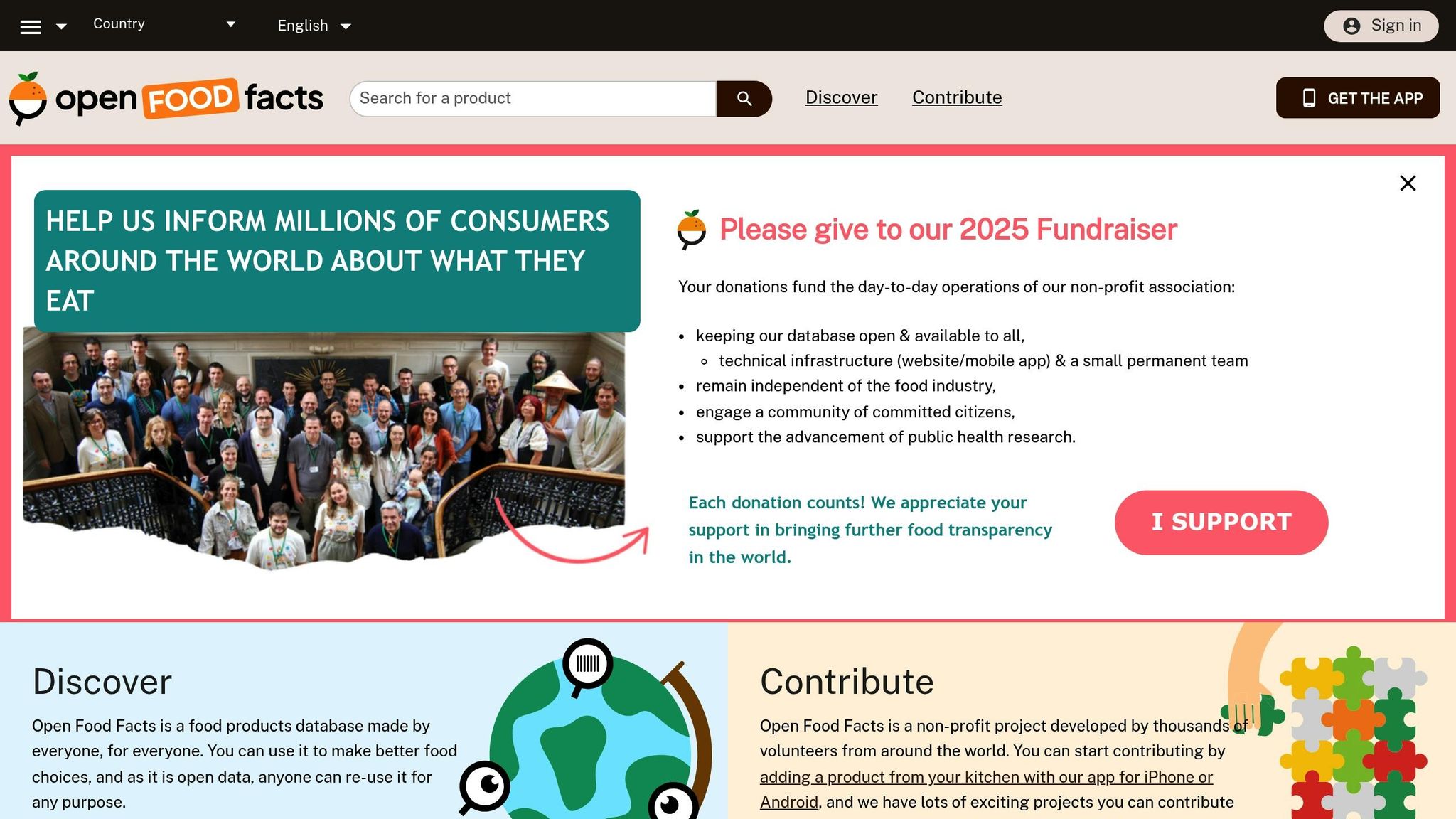
The Open Food Facts API, often called the "Wikipedia of food products", provides free, community-sourced nutrition data. This platform offers restaurant owners and developers a cost-effective way to access detailed nutrition information without relying on expensive proprietary databases.
The Open Food Facts database boasts over 2.5 million food products from more than 180 countries. While it includes a substantial selection of U.S. grocery and packaged foods, it’s not as extensive as some commercial databases. That said, it still offers a wide range of items, including branded products, basic ingredients, and even some restaurant foods. Each entry typically includes nutrition facts, ingredient lists, allergen information, and barcode metadata.
Since the data is crowd-sourced, accuracy can vary. Contributors are encouraged to upload nutrition labels for transparency, but the database doesn’t guarantee full FDA compliance. On the plus side, its open nature allows for quick updates and corrections. Many U.S. products feature entries that align with standard Nutrition Facts panels. For critical allergen tracking in U.S. restaurants, it’s wise to double-check key items with official sources to ensure reliability.
The API is easy to integrate, thanks to its well-documented RESTful design. It uses standard HTTP requests and delivers data in JSON format, making it compatible with most modern development tools. Additionally, the open-source community provides sample code, SDKs, and active forums for troubleshooting. Developers can use features like barcode lookup and search endpoints to easily incorporate nutrition data into their applications. This flexibility makes the API a solid foundation for meeting U.S. menu labeling requirements.
The API is designed with global users in mind but includes features tailored for U.S. applications. Nutritional data is available in both metric and imperial units, with many U.S. entries using familiar serving sizes like ounces and cups. While the API doesn’t include pricing information, it focuses entirely on nutrition details. For U.S.-based projects, it’s important to verify that the data meets local labeling standards, as completeness can vary by product. The database operates under the Open Database License (ODbL), allowing free use, modification, and redistribution for commercial purposes, as long as proper attribution is provided.
The database is constantly updated by a global community of contributors, with new products and corrections added daily. While this ensures a steady flow of updates, some entries may lag behind recent product reformulations or launches, especially for niche or smaller U.S. brands.
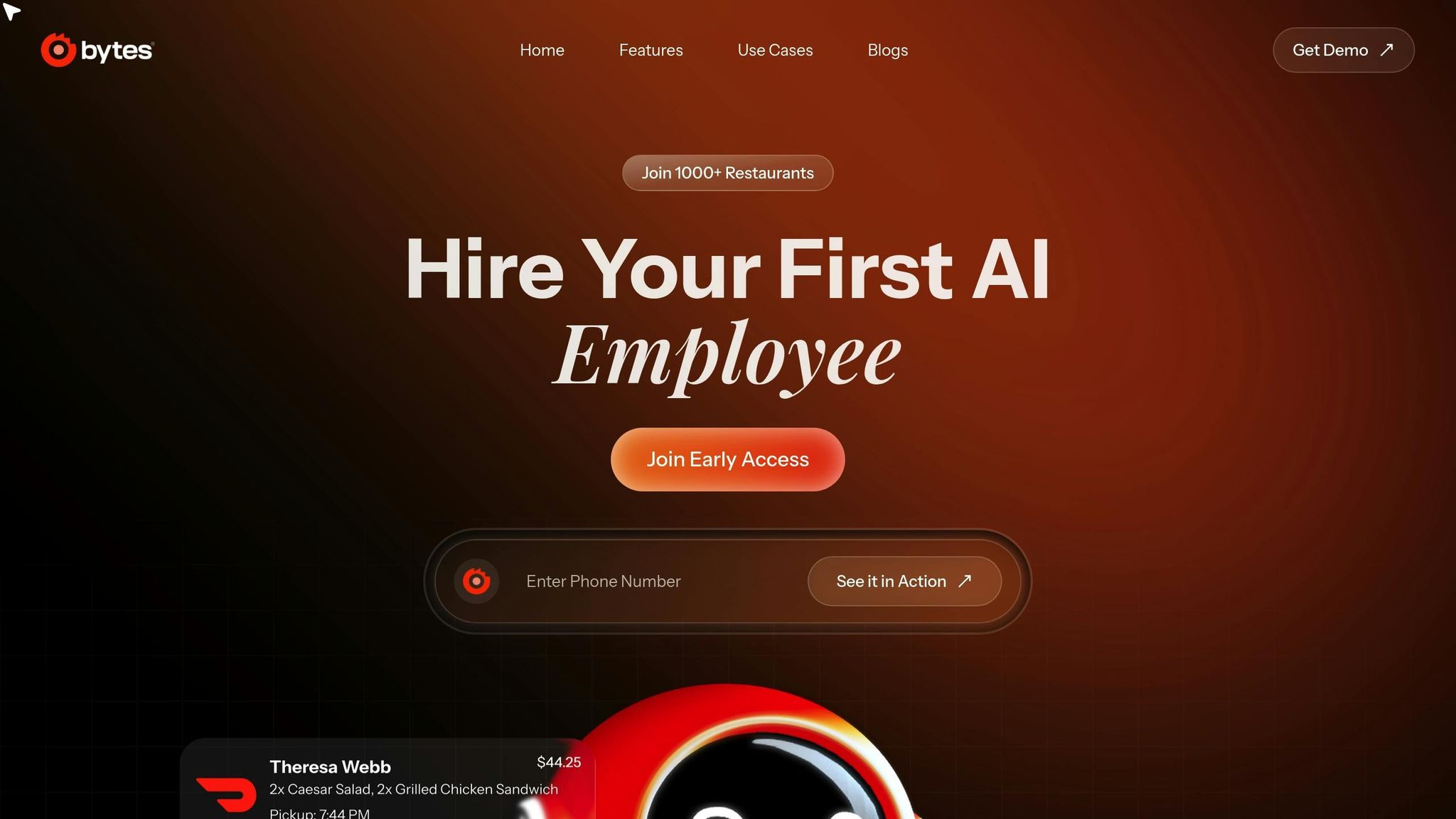
Bytes AI is transforming restaurant technology by introducing AI-driven tools for managing menus and nutritional data. With its upcoming features, the platform is set to assist U.S. restaurants in streamlining their nutrition data management, offering a tailored approach that prioritizes accuracy and compliance.
Bytes AI focuses on restaurant-specific data, moving beyond generic food databases to provide solutions tailored to individual menus. By aggregating menu data and integrating with major online ordering systems, Bytes AI ensures restaurants have access to accurate, updated information that reflects their unique offerings.
Instead of competing with vast databases like Nutritionix's 1.9 million food items or Edamam's 900,000+ entries, Bytes AI emphasizes centralizing data for restaurant menus. This allows restaurants to maintain precise nutritional details, even for custom recipes and seasonal changes, ensuring their data remains relevant and reliable.
At its core, Bytes AI delivers AI-powered tools that simplify nutritional data management while adhering to U.S. standards. Features like menu inquiries and an upcoming specialized POS system are designed to help restaurants meet FDA menu labeling requirements and disclose allergen information. With a centralized dashboard, restaurants can update menu items and nutritional data across platforms, minimizing errors and inconsistencies.
Bytes AI is built for seamless integration with modern restaurant technologies. It connects effortlessly with major online ordering platforms and provides custom-branded websites and apps. With support for RESTful APIs, webhooks, and POS system integration, the platform’s architecture is flexible enough to adapt to various tech stacks. Features like centralized order aggregation and automated reservation booking further enhance its usability.
By 2025, Bytes AI is expected to power operations for numerous U.S. restaurants, integrating directly with POS systems to streamline order entry and offer personalized customer recommendations.
Designed specifically for U.S. restaurants, Bytes AI uses imperial units, U.S. currency formats (e.g., $12.99), and adheres to American labeling standards for calories, allergens, and serving sizes. This localization ensures that menu and nutritional data align with both consumer expectations and regulatory requirements.
The platform also supports multilingual communication in English, Arabic, and Spanish, making it accessible to diverse audiences. By integrating with health and wellness apps, Bytes AI enables restaurants to link their menu nutrition data with customer tracking tools. This helps diners manage their dietary needs, monitor allergies, and make informed meal choices.
Here's a quick look at some of the top nutrition APIs, comparing their database size, US compliance, pricing, integration options, and compatibility with health apps. This table complements the detailed reviews above by highlighting each API's key features.
| API | Database Size | US Compliance | Pricing | Integration Support | Health App Compatibility |
|---|---|---|---|---|---|
| Edamam | 900,000+ foods, 2.3M recipes | Yes | Free–$999/month | REST, GraphQL, SDKs, detailed documentation | Yes (Apple Health, MyFitnessPal) |
| USDA FoodData Central | 300,000+ foods | Yes (FDA verified) | Free | REST API, public documentation | Yes |
| Nutritionix | 1.9M+ foods, 202,000+ restaurant items | Yes | Free–$1,850+/month | REST, SDKs, natural language processing | Yes (direct integrations) |
| Spoonacular | 365,000+ recipes | Partial | Free–$149/month | REST API, documentation | Yes |
| Nutritics | 800,000+ foods/recipes | Yes | Custom pricing, free trial | REST API, documentation | Yes |
| FatSecret | 1.9M+ foods | Yes | Free–Custom enterprise | REST API, barcode scanning | Yes (major health platforms) |
| Open Food Facts | User-contributed database | Partial | Free | REST API, open source | Yes |
| Bytes AI | Restaurant-specific menus | Yes (US standards) | $259.99–$279.99/month | REST, POS integration, webhooks | Yes (upcoming features) |
For smaller businesses or those on a tight budget, free options like USDA FoodData Central or Open Food Facts are excellent starting points. Meanwhile, restaurants with specific needs might find Nutritionix or FatSecret's enterprise plans worth the investment. Mid-sized operations often benefit from Edamam’s balance of comprehensive data and scalable pricing. Use this guide to pinpoint the API that aligns best with your goals.
Picking the right nutrition API can revolutionize how your restaurant manages menu transparency and connects with health-conscious diners. Each API brings its own set of strengths, catering to a variety of restaurant needs.
Edamam delivers wide-ranging dietary coverage and quick nutrition analysis. USDA FoodData Central provides free, government-supported data, while Nutritionix excels with dietitian-verified entries and natural language processing. Spoonacular focuses on recipe-based solutions and even includes cost breakdowns. FatSecret offers practical tools like barcode scanning and multi-language support. Open Food Facts stands out as a budget-friendly, community-driven option. Meanwhile, Bytes AI simplifies menu management with AI-powered nutritional updates and seamless POS integration.
When selecting an API, consider your restaurant's specific needs, such as data requirements, regulatory compliance, integration capabilities, and budget. Many providers offer free trials or entry-level plans, allowing you to explore their functionality before committing. Starting with a free option like USDA FoodData Central can help you meet basic compliance needs while leaving room to scale as your business grows.
The right nutrition API doesn’t just help you stay compliant - it builds trust with your customers, streamlines your operations, and keeps you connected to the health and wellness tools that today’s diners value.
When choosing a nutrition API for your restaurant, prioritize data accuracy, compatibility with your features, and how smoothly it integrates with your current systems. You'll also want to ensure the API can handle your menu's specific requirements, such as managing allergen information, calorie tracking, and detailed ingredient breakdowns.
Budget is another key factor - take a close look at the API's pricing structure to confirm it fits within your financial plans. Some platforms, like Bytes AI, simplify the process by offering easy integration with popular online ordering systems, making menu management and nutritional data handling much more efficient.
When assessing nutrition APIs for menu data, it's important to focus on a few key aspects, even though specific details about database sizes and compliance features aren't provided here. Look at the range of nutritional data the API offers, whether it adheres to both local and international food labeling laws, and how well it integrates with health and wellness platforms. Make sure the API you choose aligns with your restaurant's unique requirements and meets industry expectations.
APIs such as Edamam and Nutritionix prioritize precision by pulling nutritional information from reliable sources like trusted databases, food labels, and regulatory guidelines, including standards established by the U.S. FDA. They rely on advanced algorithms and frequent updates to keep their data aligned with the latest regulations.
Many of these APIs also integrate user feedback and verification processes to enhance the quality of their data. While their systems are thorough, businesses should still carefully review the API documentation and conduct their own checks to meet specific compliance needs.